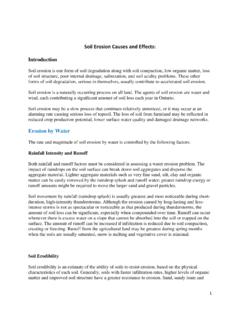Transcription of Trees and Ecosystem Services Trees and Water - Envirothon
1 Trees and Ecosystem Services Trees are indicators of a community's ecological health. While urban ecology is more complex than just tree cover, Trees are good indicators of the health of an urban Ecosystem . When Trees are large and healthy, the ecological systems-soil, air and Water -that support them are also healthy. In turn, healthy Trees provide valuable environmental benefits. The greater the tree cover and the less the impervious surface, the more Ecosystem Services are produced in terms of reducing stormwater runoff, increasing air and Water quality, storing and sequestering atmospheric carbon and reducing energy consumption due to direct shading of residential buildings.
2 Trees and Water Stormwater Runoff Reduction Trees and soils function together to reduce stormwater runoff. Trees reduce stormwater flow by intercepting rainwater on leaves, branches, and trunks. Some of the intercepted Water evaporates back into the atmosphere, and some soaks into the ground reducing the total amount of runoff that must be managed in urban areas. Trees also slow storm flow, reducing the volume of Water that a containment facility must store. For example, in the Metropolitan Washington DC region, the existing 46 % tree canopy reduces the need for retention structures by 949 million cubic feet, valued at $ billion per 20-year construction cycle (based on a $5/cubic foot construction cost).
3 Our studies show that impervious surfaces have increased by 20% over the past 2 decades in urban areas at a cost in excess of $100 billion nationally. Local governments are increasingly looking toward non-built stormwater management strategies, including Trees to reduce the cost of constructing stormwater control infrastructure. Trees and Water Quality When stormwater hits impervious surfaces in urban areas, it increases the Water temperature and also picks up various pollutants, everything from excess lawn fertilizers to oils on roadways.
4 This translates into Water quality problems when large volumes of heated stormwater flow into receiving waters, posing threats to temperature sensitive species, such as trout and small invertebrates, as well as providing conditions for algal blooms and nutrient imbalances. tree cover helps intercept rainwater, thus reducing the amount, and speed, of stormwater along with filtering pollutants that eventually flow to receiving waters. The Environmental Protection Agency (EPA) regulates Water quality, including those from non-point source pollutants such as stormwater runoff.
5 As cities recognize the high costs of controlling stormwater through "gray infrastructure," they are looking for innovative ways to inexpensively install effective controls. In 2003, new Clean Water Act regulations issued under Stormwater-Phase II provide cities with opportunities to incorporate Trees into specific environmental practices. Trees and Air Quality Air pollution in our cities and even our suburbs is a serious concern. The burning of fossil fuels has introduced a steady flow of deadly pollutants into our atmosphere, yet very few urban areas can meet national clean air standards.
6 Luckily, we are surrounded by efficient air cleaning machines- Trees . Trees remove many pollutants from the atmosphere, including nitrogen dioxide (NO2), sulfur dioxide (SO2), ozone (O3), carbon monoxide (CO), and particulate matter of ten microns or less (PM10). David Nowak, , of the USDA Forest Service conducted research in 55 cities and developed a methodology to assess the air pollution removal capacity of urban forests with respect to the above pollutants. Economists multiply the number of tons of pollutants by an "externality" cost-that is a cost that society would have to pay in areas such as health care, if Trees did not remove these pollutants.
7 Dollar values for pollutants are based on the externality costs set by the Public Service Commission in each state. Trees and Air Quality around the Country Pounds of pollutants removed Annual value of Trees with respect to City annually by tree air pollution Washington, DC 878,000 $ million Atlanta, GA Metro 19,000,000 $47 million Area Portland, OR Metro 2,000,000 $ million Area Denver, CO Metro 1,100,000 $ million Area Trees and Carbon In addition to improving air quality, Trees are able to absorb atmospheric carbon, which reduces greenhouse gases and thought to contribute to global warming.
8 The carbon related function of Trees is measured in two ways: storage, or the total amount currently stored in tree biomass, and sequestration, the rate of absorption per year. tree age greatly affects the ability to store and sequester carbon. Older Trees store more total carbon in their wood and younger Trees sequester more carbon annually. Using research from Dr. E. Gregory McPherson, USDA Forest Service, American Forests has developed a method for estimating the energy conservation benefits of Trees from direct shading of one and two-story residential buildings.
9 While there is no current economic measurement of the value of carbon sequestration in the international markets are trading carbon today and these may also be traded in the before too long. Trees and Energy Conservation Anyone who has ever sat under a tree on a hot summer day has appreciated the cooling ability of Trees , but Trees can do more than just provide shade for a picnic. Trees cool our neighborhoods in the summer and save us money on energy costs and related air pollution. American Forests has developed a method for estimating the energy conservation benefits of Trees from direct shading of one and two-story residential buildings.
10 This method is the result of research conducted by Dr. E. Gregory McPherson of the USDA Forest Service. Trees are most effective when located to shade air conditioners, windows, or walls and when located on the side of the home receiving the most solar exposure. In many parts of the country the west side is most valuable, followed by the east and south, although this ranking can change based on geographical considerations. In a study released in August 2001, American Forests found that tree cover in the metro Atlanta area saved residents approximately $ million annually in reduced energy costs.






